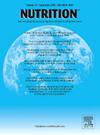哥伦比亚社区老年人肌肉生长抑制素、肌肉素、营养状况和功能之间的关系:一项横断面研究
IF 3.2
3区 医学
Q2 NUTRITION & DIETETICS
引用次数: 0
摘要
目的与身体成分变化相关的衰老会导致肌肉质量和力量下降,从而影响老年人的功能。肌生长因子和肌球蛋白是调节肌肉新陈代谢的肌动因子,可调节衰老过程中肌肉的变化。我们的目的是确定老年人肌生长激素、肌肉蛋白和营养状况与身体机能之间的关系。方法这是一项横断面研究,研究对象是分层随机抽样人口调查的一个子样本,居住在社区的 60-90 岁男女老年人。采用 MILLIPLEX 技术(美国默克密理博公司)测量血清肌生长激素和肌球蛋白的浓度。训练有素的工作人员记录体重指数(BMI)、腰围(WC)、小腿围(CC)和手臂围(AC),作为营养状况的指标。功能测试包括手握力(GS)、步行速度(WS)和高级日常生活活动能力。结果 在 101 名参与者中,55.4% 为女性,56.4% 年龄在 60 岁至 69 岁之间,53.5% 有腹部肥胖症,23.8% 有动力不足症,33.7% 有低 WS 症。肌节蛋白和肌球蛋白在 60 至 90 岁期间均无明显变化。在多元线性回归模型中,男性肌节蛋白与体重指数、CC和AC呈负相关(P< 0.05),但不能解释GS或WS。在类似的分析中,肌肉蛋白和 WC 与 GS 呈反向相关(P < 0.05)。结论 肌促性蛋白和肌球蛋白不会随着年龄的增长而减少,它们与营养和新陈代谢状况有关。肌肉蛋白与老年人的动态肥胖有关。本文章由计算机程序翻译,如有差异,请以英文原文为准。
Relationship between myostatin, musclin, nutritional status, and functionality in older Colombian community-dwelling adults: a cross-sectional study
Objectives
Aging-associated body composition changes lead to a decrease in muscle mass and strength, affecting the functionality of older adults. Myostatin and musclin are myokines that regulate muscle metabolism and may modulate muscle changes during aging. Our objective was to determine the relationship between myostatin, musclin, and nutritional status with physical functionality in older adults.
Methods
This was a cross-sectional study of a subsample of a stratified random sampling population survey in community-dwelling 60–90-year-old adults of both sexes. Serum myostatin and musclin concentrations were measured using MILLIPLEX technology (Merck Millipore, USA). Trained personnel recorded body mass index (BMI), and waist (WC), calf (CC), and arm (AC) circumferences as indicators of nutritional status. Functionality tests included handgrip strength (GS), walking speed (WS), and Advanced Activities of Daily Living.
Results
Of 101 participants, 55.4% were women, 56.4% were between 60 and 69 years old, 53.5% had abdominal obesity, 23.8% had dynapenia, and 33.7% had low WS. Neither myostatin nor musclin showed significant changes from 60 to 90 years. In a multiple lineal regression model, myostatin showed an inverse correlation with BMI, CC, and AC in men (P < 0.05) but did not explain GS or WS. In a similar analysis, musclin and WC showed an inverse correlation with GS (P < 0.05). Moreover, myostatin was lower in the more physically active men (P < 0.05) but musclin did not show any relationship with the Advanced Activities of Daily Living scale.
Conclusions
Myostatin and musclin do not decrease with aging and are associated with nutritional and metabolic status. Musclin is associated with dynapenic obesity in older adults.
求助全文
通过发布文献求助,成功后即可免费获取论文全文。
去求助
来源期刊

Nutrition
医学-营养学
CiteScore
7.80
自引率
2.30%
发文量
300
审稿时长
60 days
期刊介绍:
Nutrition has an open access mirror journal Nutrition: X, sharing the same aims and scope, editorial team, submission system and rigorous peer review.
Founded by Michael M. Meguid in the early 1980''s, Nutrition presents advances in nutrition research and science, informs its readers on new and advancing technologies and data in clinical nutrition practice, encourages the application of outcomes research and meta-analyses to problems in patient-related nutrition; and seeks to help clarify and set the research, policy and practice agenda for nutrition science to enhance human well-being in the years ahead.
 求助内容:
求助内容: 应助结果提醒方式:
应助结果提醒方式:


